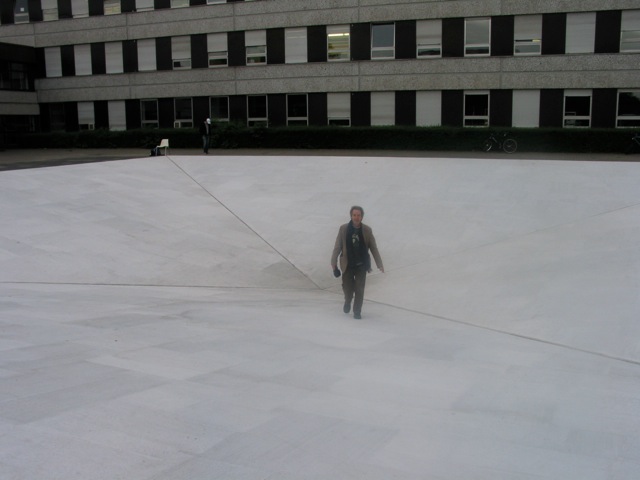NER Digital is New England Review’s online project dedicated to original creative writing for the web. “Confluences” is a bi-weekly series in which we present a writer’s encounter with a work of art such as a book, play, poem, film, painting, sculpture, or building. We launch our series with Michael Coffey’s “Waiting for Nauman.”

Photo by Rebecca Smith
I never wanted to go to Germany. So much unimaginable blood and death and guilt there. I didn’t need it. But my wife, Becca, is an artist, and we decided to go to Germany for art—to visit the once-every-five years documenta show in Kassel and the once-a-decade Skulptur Projekte in Münster, a lovely Catholic city that had been mercilessly bombed in the war, but which now bristled, shone, and surprised with permanent sculptures added to the cityscape every ten years.
I didn’t like Kassel, our first stop. The art show was spread all over and we went from room to room and building to building and saw the kind of art you can see in trendy Chelsea galleries. Then, a long walk up an absurdly steep hill through a small forest cut by a terraced waterfall to a gaudy palace once inhabited by Kaiser Wilhelm. Dull old masters there, and no fun to look down upon the town from such a redoubt—a view of a quaint city that had once been a local subcamp of Dachau.
Doubtful of what I might find in Deutschland, I’d determined to reread Beckett’s trilogy during the trip—I had a scholarly interest in Beckett’s second stay in Berlin, in 1936, when he was looking at art and hiding out from some legal contretemps and a romantic humiliation back in Dublin. On the train from Kassel to Münster, I was nearing the finish—the end of The Unnamable—which I knew contained a hideous image—a creature of sorts, a single thorax, with vacuoles at either end, one unlidded eye, a large worm with human consciousness—sited in a place that had eluded my ability to envision it.
They look down upon him . . . he’ll have to climb to meet them . . . The slopes are gentle that meet where he lies, they flatten out under him . . . . This grey to begin with . . . a nice grey, of a kind recommended as going with everything, urinous and warm.
We checked into our hotel and set out to see what we could on our first day. We had a map of art works and locations. Some were bells that chimed at intervals where buildings once stood; one was a recorded chant beneath a bridge. Another was an encampment of objects such as a routed circus troupe might leave, on the side of a hill. Jenny Holzer had a granite bench in a park with an antiwar inscription.
In late afternoon, we rode bikes looking for a Bruce Nauman work. It was supposedly near a small campus on the outskirts of town. After canvassing the site once and finding nothing, we checked the map, and tried again. And there it was, an empty space, a plot of sorts, in the ground: Nauman’s Square Depression—four concrete triangular planes sloping from ground level to a vertex in the center about six feet beneath ground level. The place of the unnamable.
The first light rain all week began to fall. I waited for some visitors to the site to leave, and slowly they did, so I could have Nauman’s work to myself. I walked down his Square Depression. At first, walking toward the center, I felt I was entering a drain or a spill catch. When I arrived at the bottom, however, I looked up, as one will. The sky sat above me, stilted by the four cardinal points. I was in an architecture of both earth and heavens. No longer a sluiceway but a kind of reverse temple, reaching down—a conceptual verso to the sacrificial altar to Zeus. The sky above was gray. Becca stood on the apron at the top; she took my picture. I felt for the moment invisible in Germany but in it, six feet under but alive, hidden from all but my wife and the eye of the sky, just me there. I have the photograph.
Then we walked down toward a body of water; saw a frank Donald Judd piece there—two chest-high, foot-thick concrete rings, one inside the other, set on a gentle slope; and a sublime redwood pier built by Jorge Pardo that angled out from shore to brave the middle of the long, narrow lake. We wandered to the end of the pier and sat down. It was evening. Lights came up in Münster, streetlamps counting off their measures and car lights winding their way along the lake drive into town. I wanted to live right there, on the water, in the words we spoke about what we had seen that particular day—the art, the fourteenth-century Catholic cathedral, half-destroyed by the RAF in 1945, rebuilt with the help of the citizens of Coventry. We felt ourselves very much in a world of history—frozen, broken, yet restored. Something horrific had been pounded out here in Münster, perhaps in all of Germany. The dead souls that flew, that flew above us in the dark I couldn’t see, but I knew they were there. I could imagine them. It was Nauman’s piece that made me look up.
Michael Coffey’s collection of stories, The Business of Naming Things, will be published by Bellevue Literary Press in January 2015. His most recent pieces in NER include “Sons,” in NER 34.1, and “I Thought You Were Dale,” in NER 32.3.
